Nestled within the arid and diverse landscapes of Arizona, a tapestry of shrubs thrives, adding beauty, color, and resilience to this southwestern state. Explore the fifteen best shrubs to plant in Arizona, tailored to the Copper State’s unique climate, and transform your outdoor space into a thriving oasis. From vibrant flowering species to steadfast evergreens, we will delve into each shrub’s ideal planting times, growth rates, and regional insights to ensure your landscaping efforts flourish.
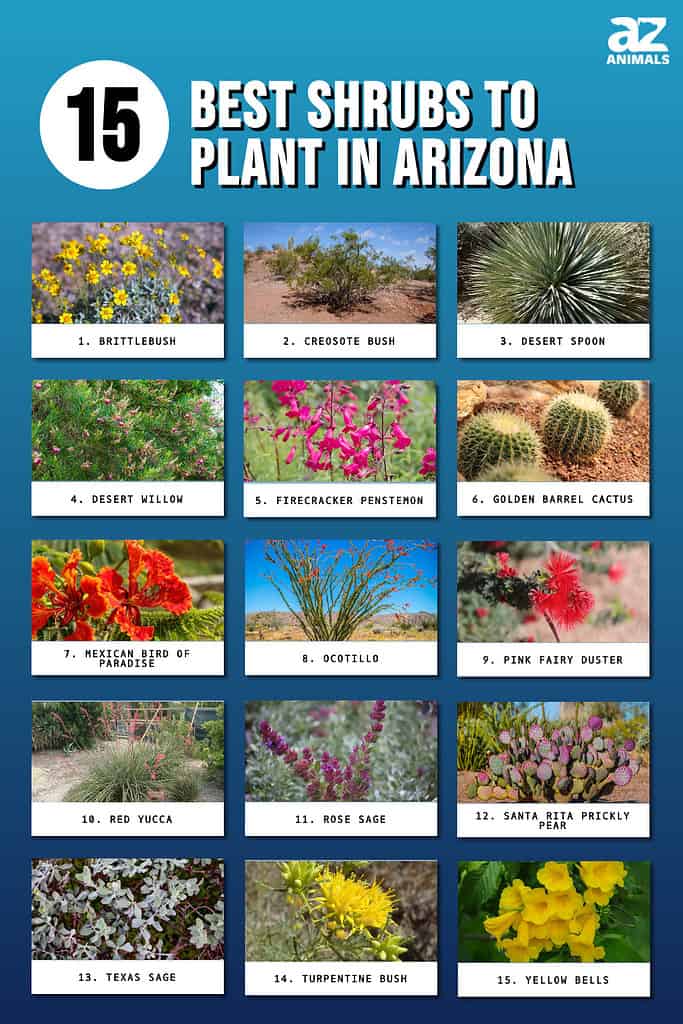
1. Brittlebush (Encelia farinosa)
Commonly known as incienso, Brittlebush is a resilient desert native that thrives in full sunlight. It is a staple in Arizona xeriscapes, and its minimal watering needs make it perfect for water-conscious gardeners. Brittlebush paints the landscape with its daisy-shaped, golden-yellow blooms in the late winter through spring, inviting local pollinators. Additionally, its fuzzy and sticky leaves are silver-gray and grow along long, slender stems, providing year-round interest.
The moderately sized bushy evergreen shrub reaches up to 4 feet tall and flourishes throughout Arizona, from the Sonoran Desert to the Mojave, but it truly shines in the lower elevations. It is not too picky about soil types, adapting to Arizona’s varied terrains. However, brittlebush does not tolerate soggy roots and is prone to root rot.
It is drought-tolerant, and its silver-gray leaves reflect sunlight, reducing water loss through transpiration. Furthermore, the resinous coating on its leaves acts as a natural sunscreen, protecting the plant from intense sunlight. Indigenous peoples of the region, such as the Tohono O’odham and Pima tribes, have a long history of using Brittlebush for medicinal purposes. Plant specimens in garden beds and borders.
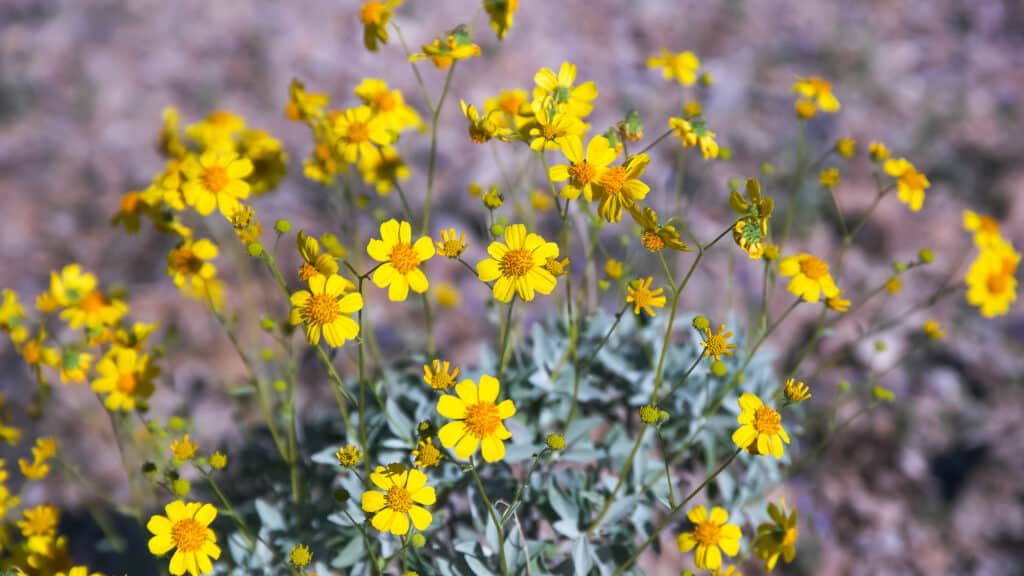
Brittlebush is a member of the sunflower family.
©iStock.com/crbellette
2. Creosote Bush (Larrea tridentata)
Creosote bush is a hardy evergreen shrub that has adapted to the arid landscapes of the Copper State. It reaches up to 6 feet tall, featuring a dense, rounded shape and dark green branches. Creosote bush produces tiny, oval-shaped leaves with resinous coatings. The coatings give the shrub a strong fragrance, often described as rain-soaked earth and creosote. After rainy spring periods, the resilient plant produces small, yellow, five-petaled flowers that add a delicate charm.
Creosote bush thrives in full sun and well-draining soil. It is also drought-tolerant and makes an excellent addition to xeriscapes, natural landscapes, privacy screens, hedgerows, and windbreaks. The evergreen shrub grows best in the low desert regions of southern Arizona, including the Sonoran Desert, but also performs well in the high desert areas of northern and Central Arizona. Unfortunately, it does not grow well in the riparian areas near streams and waterways.
The showy evergreen is extremely long-living. In fact, experts estimate that some individual specimens in Arizona are thousands of years old and among the oldest living organisms on Earth. Additionally, indigenous peoples have used creosote bush for medicinal purposes, including as a tea to treat various ailments.
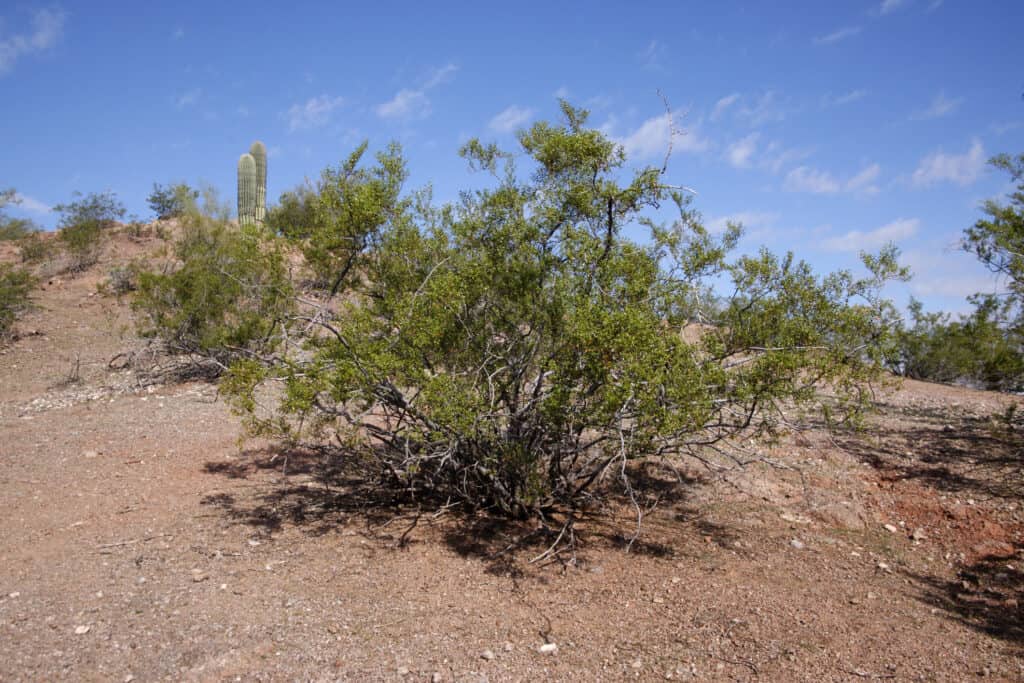
The Creosote bush is a medium-sized evergreen shrub.
©iStock.com/MikeLane45
3. Desert Spoon (Dasylirion wheeleri)
Desert spoon is a striking and drought-tolerant shrub with a unique appearance and adaptability. Its distinctive appearance adds architectural elements to landscapes. The succulent forms a spherical rosette of long, narrow, and rigid leaves that radiate from a central point. The leaves have a bluish-green hue and sharp, toothed edges.
In late spring to early summer, desert spoon produces a tall, slender flowering spike that reaches up to 15 feet and is adorned with small, creamy-white flowers. The evergreen shrub thrives in full sun and well-draining soil. It is an ideal choice for xeriscapes, accent additions, and rock gardens. It also has a long lifespan, with some specimens living for several decades.
The tall flowering spike attracts pollinators such as bees and hummingbirds, contributing to local biodiversity. Indigenous peoples have traditionally used desert spoons for various purposes, including fiber production for weaving and making brushes. You can find specimens growing in both the low and high desert regions of Arizona.
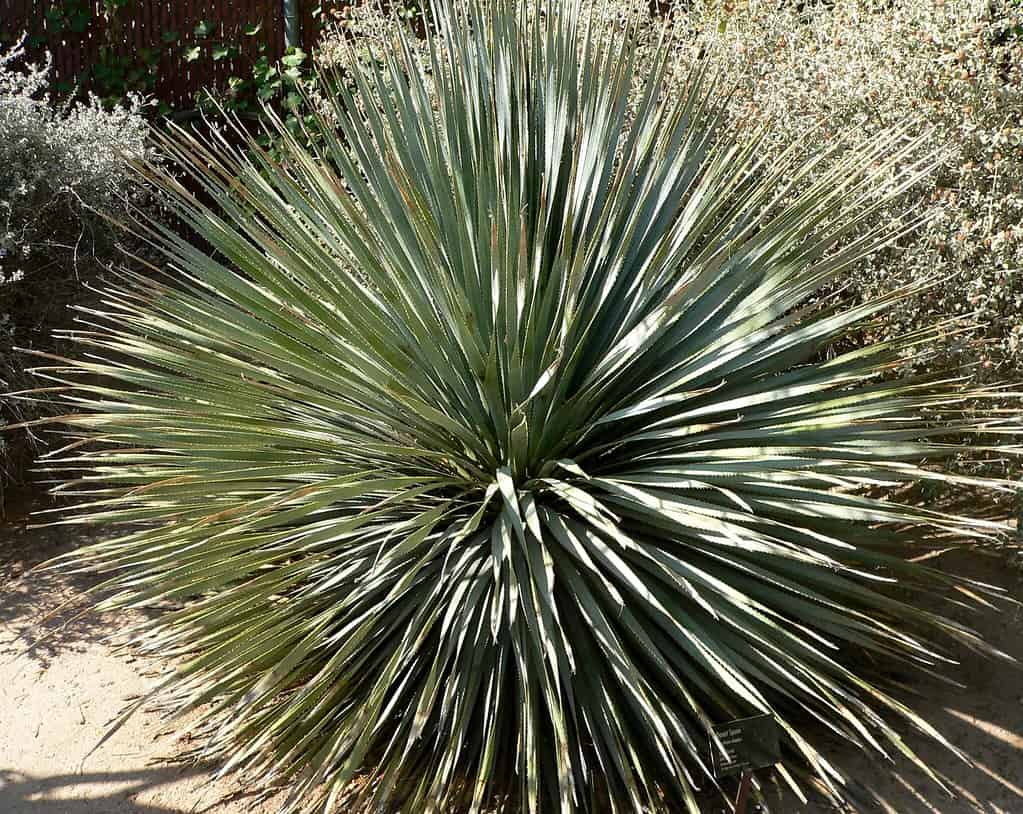
Desert spoon can live up to 100 years or more.
©Stan Shebs, CC BY-SA 3.0 , via Wikimedia Commons – License
4. Desert Willow (Chilopsis linearis)
Also known as willow-leaved catalpa, orchid of the desert, and flowering willow, desert willow is a native deciduous shrub with an elegant appearance and vibrant flowers. The shrub typically grows to heights between 15 to 30 feet, with a slender, vase-like shape. Additionally, its branches are often pendulous and create a weeping effect.
The leaves of desert willow are long, slender, and willow-like, providing a delicate and airy appearance. They are typically gray-green to blue-green. However, the true charm of desert willow lies in its trumpet-shaped flowers. These blooms vary in color from pale pink to deep magenta, and they appear from late spring through early fall. The flowers are also a magnet for hummingbirds and butterflies.
Specimens thrive in full sun and well-draining soil. They are also drought-tolerant and grow equally well in the high and low desert regions. Grow desert willow in borders, wildlife gardens, and as focal specimens. Unlike many desert plants that have short flowering periods, desert willow graces your garden with its beautiful blooms from late spring to early fall, providing extended color.
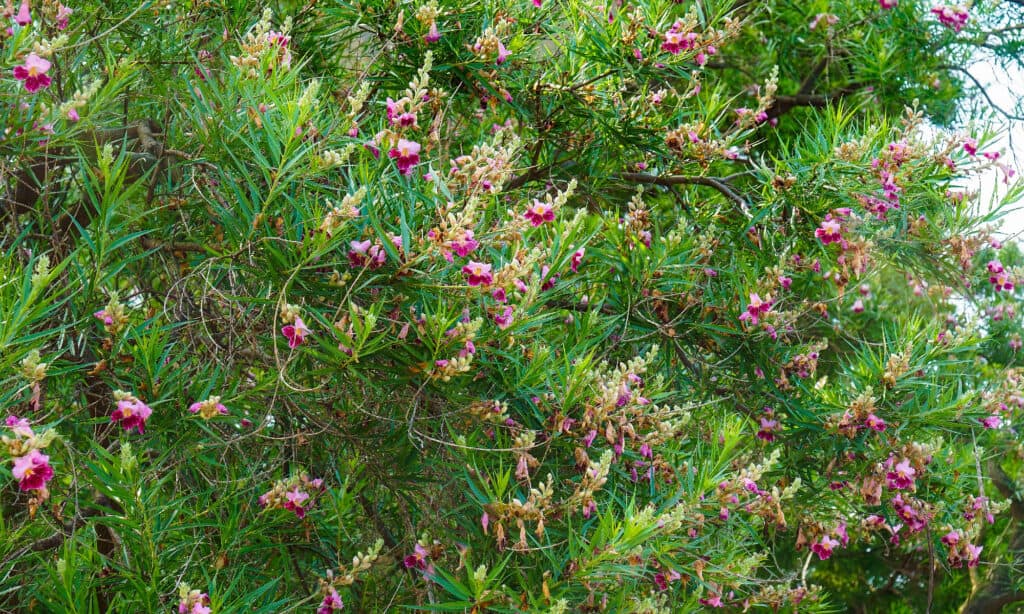
Desert willow grows well in higher elevations up to 5,000 feet.
©Nikolay Kurzenko/Shutterstock.com
5. Firecracker Penstemon (Penstemon eatonii)
Nestled within the arid landscapes of Arizona, the firecracker penstemon stands out against the desert landscapes. This striking perennial shrub produces fiery red, tubular flowers reminiscent of fireworks. It reaches up to 3 feet and also produces lance-shaped dark green leaves.
Firecracker penstemon thrives in full sun like most desert-dwellers and well-draining soil. The perennial is drought-tolerant and native to the southwestern United States. It grows well throughout the state but prefers rocky environments over clay soil.
One of its best features is its ability to attract hummingbirds. Furthermore, firecracker penstemon holds a special place in the hearts of Arizonans as a native plant that epitomizes the beauty of the state’s desert flora. Its vibrant blossoms are a source of visual delight and a testament to the resilience of nature in the arid landscape. Plant specimens in xeriscapes, rock gardens, borders, and as backdrops.
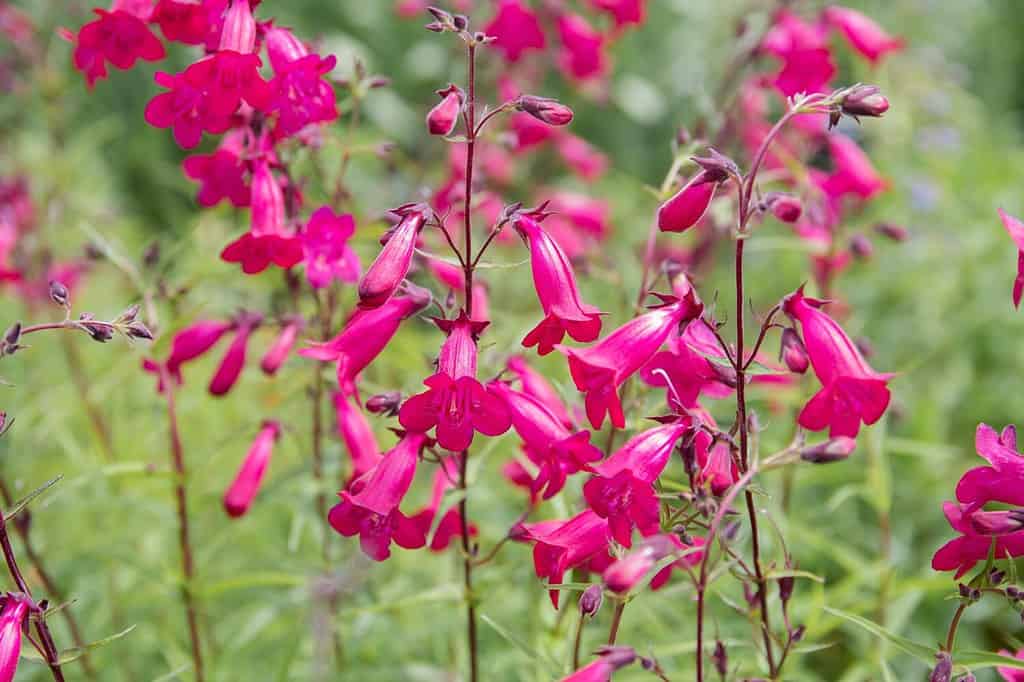
Firecracker penstemon can grow in temperatures over 100 degrees Fahrenheit.
©litts/Shutterstock.com
6. Golden Barrel Cactus (Echinocactus grusonii)
Amidst the rugged and sunbaked terrain of Arizona, the golden barrel cactus stands as an iconic symbol of desert tenacity. This remarkable cactus, with its spherical shape and distinctive golden spines, brings a touch of golden radiance to the harsh desert. Also known as golden bell cactus and mother-in-law’s cushion, the slow-growing succulent reaches up to 3 feet in diameter.
Like most cacti, the golden barrel cactus revels in the intense Arizona sun and rocky, sandy desert soils. It is also extremely drought-tolerant and a common site in the desert regions of Arizona, particularly in the Sonoran Desert.
Golden barrel cactus is slow-growing, taking several decades to reach maturity. They are also a favored nesting site for various birds. Plant specimens as focal points and in rock gardens, borders, and xeriscapes.
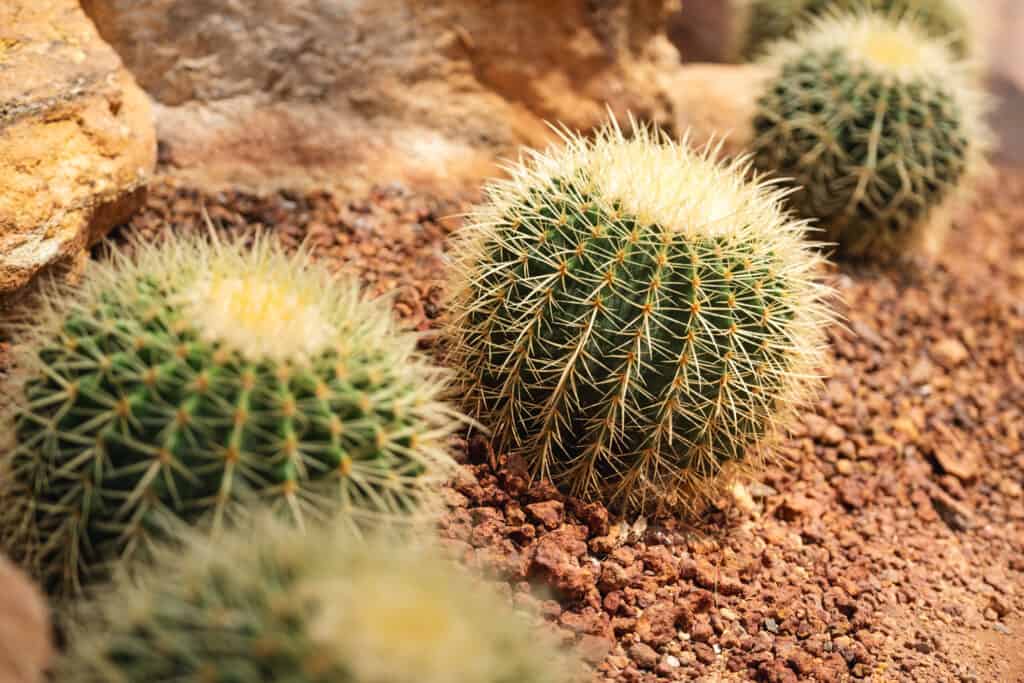
The golden barrel cactus is an endangered species in the wild.
©iStock.com/Farknot_Architect
7. Mexican Bird of Paradise (Caesalpinia mexicana)
Mexican bird of paradise is a tropical gem amid the desert’s backdrop. This captivating perennial shrub, adorned with vibrant yellow flowers reminiscent of bird-like shapes, adds an exotic touch to the state’s native landscapes. It is renowned for its graceful and tropical appearance.
The Mexican bird of paradise features finely divided, fern-like, bright green leaves and produces clusters of striking, vivid yellow flowers with long red stamens. These blossoms resemble bird-like shapes, earning it the common name “Bird of Paradise.”
The Mexican bird of paradise is a common sight in the low desert regions of Arizona, particularly in the Sonoran Desert. It thrives in the state’s hot sun and rocky soils. However, it prefers regular watering during the growing season but exhibits some drought tolerance.
The shrub’s vibrant yellow blossoms are a magnet for pollinators, including bees and butterflies, contributing to local biodiversity. Plant Mexican birds of paradise as backdrops and border plants to add a splash of versatility and color to your desert garden.
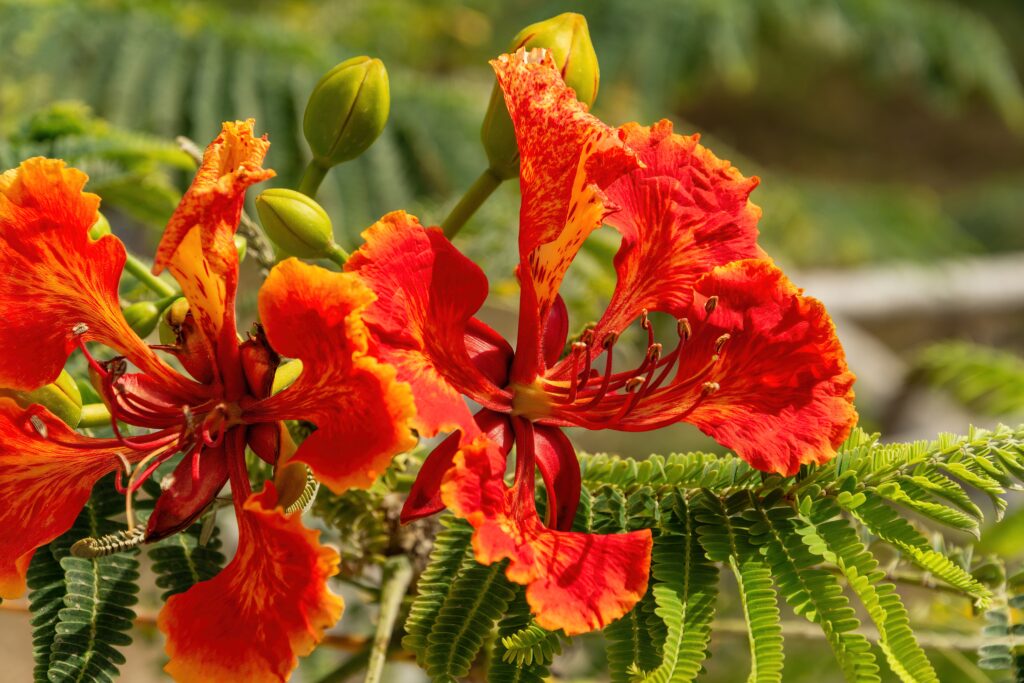
Mexican bird of paradise has sharp, prickly stems.
©Aref Barahuie/Shutterstock.com
8. Ocotillo (Fouquieria splendens)
Ocotillo is a unique desert shrub commonly known as coachwhip, Jacob’s staff, or vine cactus. The succulent produces spiny, whip-like stems and vibrant bursts of red-orange flowers. The shrub can also reach up to 20 feet. During wetter periods, its stems sprout small, vibrant leaves, creating a dramatic display of greenery. However, during dry spells, the leaves fall, leaving the stems exposed. Come spring, the Ocotillo bursts into life with fiery red-orange tubular flowers, attracting desert pollinators.
Ocotillo thrives in the extreme conditions of the state’s low desert regions. It loves full sun and well-draining soil. Specimens are drought-tolerant but produce leaves and flowers after significant rainfall. Furthermore, indigenous peoples used ocotillo for various remedies. Plant the evergreen cactus as a focal point in xeriscapes. It also makes a standout addition to rock gardens and borders thanks to its sculptural and dramatic appearance.

Ocotillo is a large shrub, reaching up to 20 feet tall.
©Cheri Alguire/Shutterstock.com
9. Pink Fairy Duster (Calliandra eriophylla)
An enchanting desert shrub, pink fairy duster, or false mesquite or pink powderpuff produces clusters of vibrant pink, powder-puff-like flowers. Its ethereal appearance is reminiscent of fairy wands. The shrub also produces fine, fern-like leaves and reaches up to 6 feet. It has a rounded and bushy shape with an upright spreading growth habit.
Pink fairy duster thrives in full sun and well-draining soils. It is fairly drought-tolerant and common in Arizona’s low desert regions, particularly the Sonoran Desert. It is a favorite among local pollinators and makes a great addition to xeriscapes, native gardens, and borders. Its vibrant blooms, adaptability, and ecological significance make it a cherished part of the state’s natural heritage and a source of wonder in the arid landscapes.
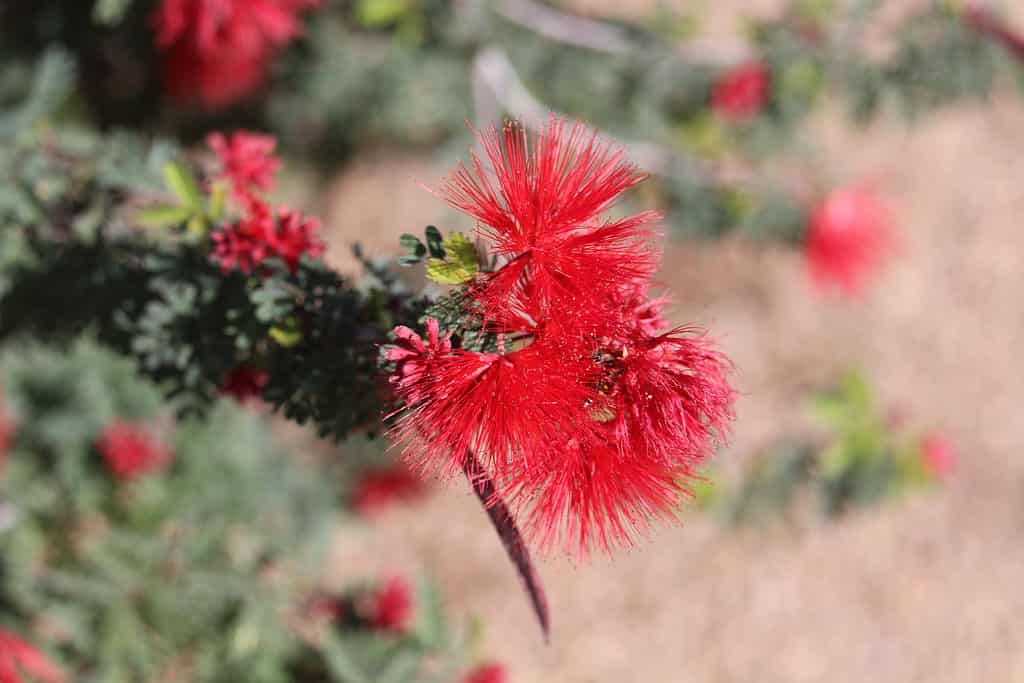
Pink fairy duster grows best in dry areas and survives with very little water.
©Selina S/Shutterstock.com
10. Red Yucca (Hesperaloe parviflora)
Arizonans love red yucca, also known as hummingbird yucca, for its striking appearance, adaptability, and resilience. It is a resilient succulent shrub that thrives in various regions across Arizona, embracing the state’s desert environment. Encounter red yucca in the low desert valleys, including the Sonoran Desert, as well as in the higher elevations of the state. Its adaptability allows it to find a home in rocky slopes, desert washes, and even urban gardens.
Red Yucca produces year-round interest thanks to its graceful rosette of arching blue-green leaves. These striking spikes, adorned with tubular coral-red or coral-orange flowers, attract hummingbirds, making it a pollinator-friendly choice for Arizona gardens. Additionally, specimens reach up to 6 feet.
Indigenous peoples, including the Apache and Pima tribes, used red yucca for its medicinal properties. The evergreen shrub is drought-tolerant and thrives in full sun. It prefers well-draining soil. Grow red yucca in xeriscapes, rock gardens, and borders.
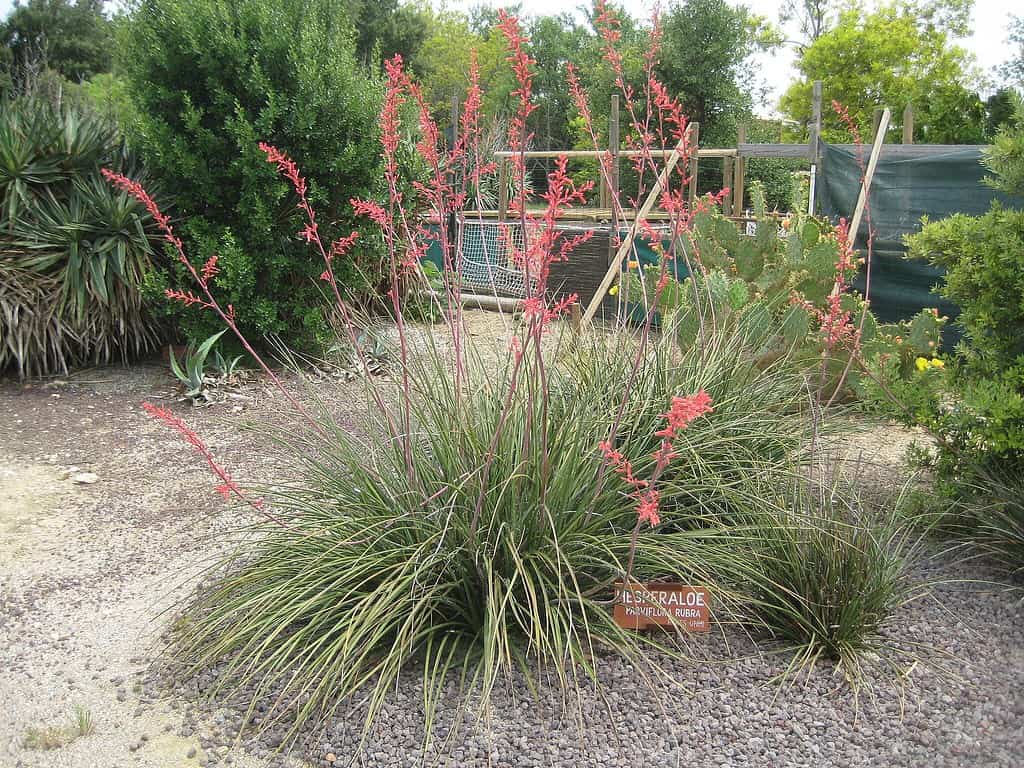
Red yucca grows well from seed and can even grow without soil.
©Sylenius, CC BY-SA 3.0 , via Wikimedia Commons – License
11. Rose Sage (Salvia pachyphylla)
With its fragrant elegance, rose sage boasts an eye-catching appearance of gray-green, aromatic leaves that have a silvery sheen. The shrub’s slender, upright stems support spikes of tubular flowers that range in color from lavender-pink to violet-blue. These striking blooms add a burst of color to the desert landscape and attract pollinators.
Also known as Mojave sage and desert rosemary, rose sage thrives across various regions of Arizona. It grows best in full sun and well-draining soil. It is also drought-tolerant and low-maintenance. Grow specimens in native gardens, xeriscapes, borders, and mixed plantings.
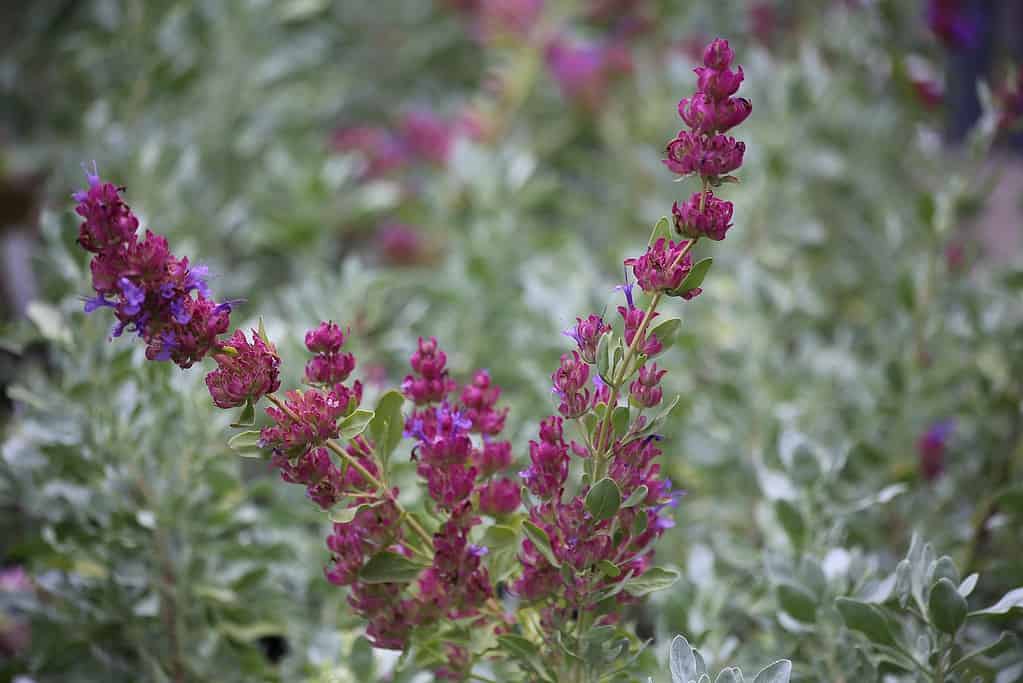
Rose sage can survive without any water all summer.
©The Friends of Manito, Public domain, via Wikimedia Commons – License
12. Santa Rita Prickly Pear (Opuntia santa-rita)
Another succulent cacti variety, Santa Rita prickly pear, produces a distinctive purple hue. Also known as purple prickly pear, The Santa Rita prickly pear features flat, paddle-shaped pads that exhibit shades of purple, blue, or bluish-purple. These colorful pads create a stunning contrast against the desert. Specimens also occasionally produce yellow flowers in the spring, followed by edible prickly pear fruits.
It grows well across Arizona, including the low and high desert regions. Both the pads (nopales) and fruits (prickly pears) are edible and have been a traditional food source for indigenous peoples in the region for centuries. Prickly pears have a sweet and slightly tart flavor.
Santa Rita prickly pear is highly drought-tolerant. Like most cacti, it also thrives in full sun and well-draining soil. Specimens reach up to 6 feet tall and make great additions to borders, native gardens, and xeriscapes.

Prickly pear is loaded with important nutrients.
©ThomasPhoto/Shutterstock.com
13. Texas Sage (Leucophyllum frutescens)
Producing vibrant blooms, Texas sage reaches up to 8 feet tall and wide. The evergreen shrub produces silver-gray to silvery-white leaves. The leaves are oval-shaped and covered with tiny hairs, contributing to their reflective quality. Texas sage also produces purple or pink tubular flowers that create a vibrant contrast against its silver foliage and invite local pollinators. Furthermore, its foliage releases an earthy fragrance after rain showers.
Commonly known as cenizo or silverleaf, Texas sage grows best in well-draining soil and full sun. It is drought-tolerant once established and also low-maintenance. Grow specimens in xeriscapes, hedgerows, borders, and native gardens. In the wild, find Texas sage growing along the rocky slopes and desert washes of the Copper State.

The older Texas sage gets, the more intensely it blooms.
©Muthita Panphloi/iStock via Getty Images
14. Turpentine Bush (Ericameria laricifolia)
Another fragrant shrub, turpentine bush releases a pleasant aroma, resembling turpentine when its leaves are crushed or brushed. It is a resilient shrub, thriving across various regions in Arizona, including the desert valleys and higher elevations. Turpentine bush flowers attract local pollinators like bees and butterflies, while its seeds provide a food source for desert birds.
The bush produces narrow, silver-gray leaves that resemble those of a pine tree. It also occasionally produces small, yellow flowers for a burst of spring color. Plant specimens in xeriscapes, borders, hedgerows, and mixed plantings. They thrive in full sun and well-draining soil and are also drought-tolerant. Additionally, specimens reach up to 6 feet tall and wide to create adequate privacy screens.

The crushed leaves of turpentine bush smell like turpentine, giving the plant its name.
©Miwasatoshi, CC BY-SA 4.0 , via Wikimedia Commons – License
15. Yellow Bells (Tecoma stans)
This semi-evergreen bush grows up to 12 feet tall and wide. Yellow bells, also known as Esperanza and yellow trumpet bush, bloom clusters of bright yellow, trumpet-shaped flowers. These radiant blooms stand out against the shrub’s dark green, pinnately compound leaves. Its blooms attract native pollinators. However, prune or pinch spent flowers to promote bushiness and repeat flowering.
Grow yellow bells in borders, pollinator gardens, hedgerows, and mixed plantings. Specimens thrive in full sun and well-draining soil. Additionally, they are drought-tolerant and intolerant of soggy roots. Find specimens growing in both the low and high desert regions of Arizona. Furthermore, yellow bells hold significance for indigenous people who used them for medicinal purposes and as a source of yellow dye.
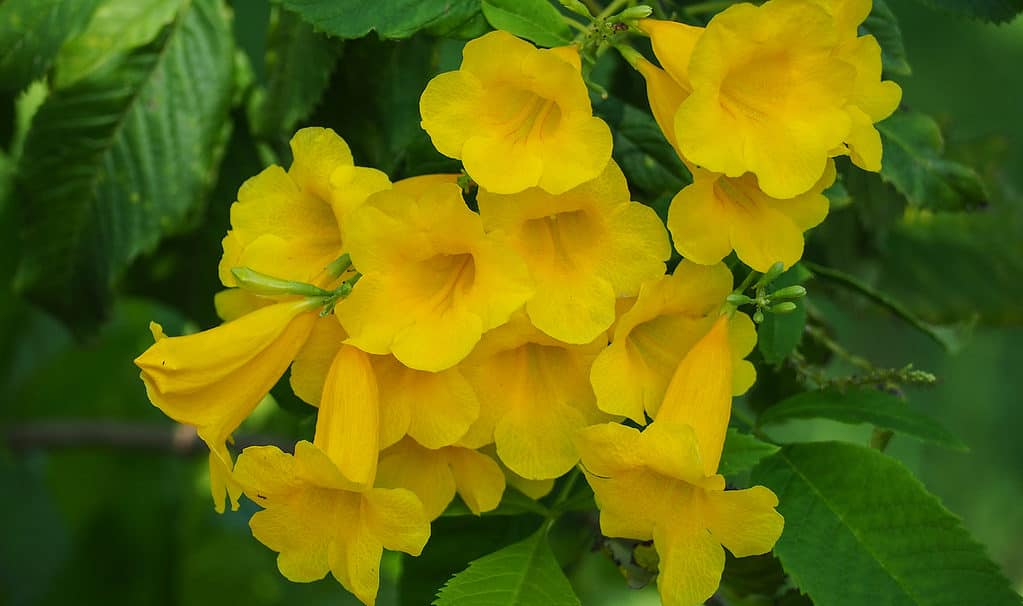
Yellow bells have medicinal properties.
©iStock.com/nongnuch vikrutha
Summary of the 15 Best Shrubs to Plant in Arizona
| Number | Common Name | Mature Height |
|---|---|---|
| 1 | Brittlebush | 3 to 6 feet |
| 2 | Creosote Bush | 4 to 12 feet |
| 3 | Desert Spoon | 4 to 6 feet |
| 4 | Desert Willow | 15 to 30 feet |
| 5 | Firecracker Penstemon | 1 to 3 feet |
| 6 | Golden Barrel Cactus | 2 to 3 feet |
| 7 | Mexican Bird of Paradise | 6 to 15 feet |
| 8 | Ocotillo | 10 to 20 feet |
| 9 | Pink Fairy Duster | 2 to 4 feet |
| 10 | Red Yucca | 2 to 3 feet |
| 11 | Rose Sage | 2 to 3 feet |
| 12 | Santa Rita Prickly Pear | 2 to 3 feet |
| 13 | Texas Sage | 3 to 8 feet |
| 14 | Turpentine Bush | 3 to 6 feet |
| 15 | Yellow Bells | 6 to 12 feet |
The photo featured at the top of this post is © khuruzero/Shutterstock.com
Thank you for reading! Have some feedback for us? Contact the AZ Animals editorial team.







